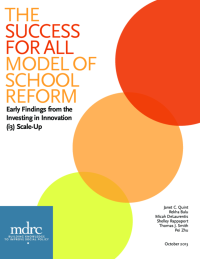The Success for All Model of School Reform
Early Findings from the Investing in Innovation (i3) Scale-Up

First implemented in 1987, the Success for All (SFA) school reform model combines three basic elements:
- Reading instruction that is characterized by an emphasis on phonics for beginning readers and comprehension for students at all levels, a highly structured curriculum, an emphasis on cooperative learning, across-grade ability grouping and periodic regrouping, frequent assessments, and tutoring for students who need extra help
- Whole-school improvement components that address noninstructional issues
- Strategies to secure teacher buy-in, provide school personnel with initial and ongoing training, and foster shared school leadership
Success for All was selected to receive a five-year scale-up grant under the U.S. Department of Education’s first Investing in Innovation (i3) competition. This report, the first of three, examines the program’s implementation and impacts in 2011-2012, the first year of operation, at 37 kindergarten through grades 5 and 6 (K-5 and K-6) schools in five school districts that agreed to be part of the scale-up evaluation: 19 “program group” schools were randomly selected to operate SFA, and 18 “control group” schools did not receive the intervention. Program and control group schools were very similar at the start of the study. The analysis compares the experiences of school staff as well as the reading performance of a cohort of kindergarten students who remained in SFA schools throughout the year (and therefore received the maximum “dosage” of the program) with those of their counterparts in the control group schools.
Key Findings
- While teachers in the SFA schools initially expressed concerns about implementing this new, complex, and demanding initiative, by the end of the first year, many teachers were beginning to feel more comfortable with the program.
- Almost all the program group schools had reached a satisfactory level of early implementation as determined by the Success for All Foundation, the nonprofit organization that provides materials, training, and support to schools operating the reform. Yet there was also ample room for schools to implement additional program elements and to refine the elements that they had put in place.
- Reading instruction in the two sets of schools was found to differ in key ways.
- Kindergartners in the SFA schools scored significantly higher than their control group counterparts on one of two standardized measures of early reading. The impact on this measure seems to be robust across a range of demographic and socioeconomic subgroups, as well as across students with different levels of literacy skills at baseline.
Subsequent reports will examine the reading skills of these students as they progress through first and second grades and will also measure the reading skills of students in the upper elementary grades.






